Devices and furnishings to reduce ligature danger

Photo courtesy of Bradley Corp.
Creating a ligature-resistant health care environment is important to preventing patient suicide and self-harm. Yet challenges abound. Manufacturers must design ligature-resistant furnishings, fixtures and devices that do not look intimidating but can withstand rugged use. Fortunately, health facilities today have an ever-expanding choice of products from which to choose.
Key challenges
Two key issues pose challenges to designing a ligature-resistant facility, according to Patrick E. Keller, designer and inventor at Norva Plastics Inc., Norfolk, Va. First, most facilities were not originally designed to be behavioral health units. Each one has unique features that can present several risks to patients. Second, certain types of patients can be more difficult to handle and more destructive within a unit. If the designer does not take that into consideration, the unit can pose a danger to patients and staff.
Some hospitals undergo renovations to improve ligature resistance. For those making incremental changes, the challenges are related to existing environmental conditions, according to Mark J. Berger, president and chief product officer at Securitech Group Inc., Maspeth, N.Y. “For example, the vendor needs to work with the safety department if there are doors leading to stairwells within a ward,” he says. “Similarly, door swings, where patients may be able to barricade themselves within a room, are a concern.”
The key is to be alert and learn from patients what new risks can come from modifying a space. “I recently visited a facility where the proximity of the outward-swinging patient room door to the in-room lavatory allowed a creative patient to tie a bed sheet and several articles of clothing together to prevent anyone from opening the door,” Berger notes.
Creating a ligature-resistant environment requires a holistic approach that considers all hazards. “I once visited a facility that had just installed ligature-resistant shower valves. However, they still had exposed pipes running along the ceiling, so the facility was just as dangerous as before,” says Chris Kopp, president of Odd Ball Industries, Greenlawn, N.Y.
Likewise, facility managers need to consider furnishings that are tamper-proof, weighted where necessary, include non-removable parts and are heavy-duty enough to endure harsh handling, advises P.J. Manzari, vice president and general manager at Nemschoff Inc., Sheboygan, Wis.
Some key areas
Anti-ligature product introductions from manufacturers cover many physical and functional areas. They include:
Doors and locks. The design of doors and how they allow or prevent access to health care spaces is important. “Lock manufacturers are always adding functions to meet unique needs. Securitech is providing new ward-entry locks to meet sally-port controlled entryway needs and code-compliant means of egress requirements. Ligature-resistant alarm elements also have been introduced,” Berger says.
Assa Abloy Door Security Solutions, New Haven, Conn., is upgrading products such as the Pemko ERS-MP, an emergency release stop, which is approved by New York State of Mental Health as an anti-barricade solution in high-risk areas. The company provides a complete ligature-resistant door opening featuring Ceco/Curries doors and frames and ligature-resistant locks from Sargent or Corbin Russwin.
The warmth of wood doors is preferred in any health care setting, but strength and durability are paramount in a behavioral health application, according to Tom Morgan, director of business development – health care. “Assa Abloy offers hollow metal doors with woodgrain patterns embossed into the steel, which, when factory-finished, produces the look of real wood. We also offer suited hardware lines where the finishes of locks can match door accessories.”
Norva Plastics Inc. offers the Sentinel Event Reduction Door, which is designed with no ligature points. The door is constructed from three-fourths-inch thick extruded polymer resins that do not splinter or crack under abuse, and may be painted to match any color scheme. It has a heavy-duty continuous hinge that mounts to the door frame or toilet partition, which eliminates any gaps that may be used as ligature points. The top of the door is angled, so anything hung over it will slide off.
Door Control Services Inc., Ben Wheeler, Texas, recently upgraded its Top Door Alarm system. This presence-detection device alerts hospital staff if a patient uses a foreign object, such as a bed sheet or item of clothing, as a ligature point at the top of a door to commit self-harm. Top Door Alarm provides the same protection at the bottom of a door, deterring patients from performing the “alligator roll” to inflict self-harm, according to Rodney Allison, director of behavioral health products. “The next generation will feature a programmable logic controller master control panel with a digital touchscreen located at the nurse station, and options to tie into a hospital’s building automation system.”
The Door Switch, St. Louis, offers a pressure-sensitive device that extends above the top of the door. If a foreign object is placed across the top and one to two pounds of downward pressure is applied, an audible alarm and strobe are activated, identifying where the event is taking place. A control panel provides an event log. The report identifies when something was placed over the door, when staff responded and when the audible alarms were turned off. The log is printable or downloadable.
More door manufacturers are designing ligature-resistant devices that do not look institutional or intimidating to behavioral patients. For example, the Top Door Alarm uses a photoelectric beam mounted to both the top of the door and the top of the frame. The beam covers are small (one-half inch by two inches) in relation to the door, giving it an aesthetically pleasing look. Also, it is less noticeable than a shiny pressure bar.
Bathrooms. Ligature resistance is an important feature in hospital restrooms where the potential for patient self-harm is great. A private bathroom may not be supervised, and mirrors, shower heads or hooks may have ligature points.
To that end, Bradley Corp., Menomonee Falls, Wis., offers the SafeCare Ligature-Resistant Series, a line of products developed for restrooms in specialized care situations. It includes handwashing fixtures, showers and accessories. The line features minimized ligature points, but also conveys home-like bathroom aesthetics to promote feelings of comfort among patients.
Bradley Corp. recently integrated a new mechanical metering push button and a metering piezo switch for many of its products, including ligature-resistant showers and its single-station lavatory. “The push button and piezo switch are ligature resistant, in that they are flush with the surface,” says Cassie Schneider, associate product manager. “They also are field adjustable to pre-set timeout periods and optional auto-flush.”
Likewise, Chicago Faucets, Des Plaines, Ill., recently introduced the ELR Series touchless faucet with built-in ligature resistance. It features heavy-duty brass construction with battery or hardwired operation. Power and mixing options, including thermostatic scald protection, are contained in a secure control box.
“Our new ELR faucet is specifically designed with sloping surfaces, a fully recessed spray outlet and no protruding buttons to minimize ligature points that may result in self-harm or loss of life,” says Greg Hunt, commercial product manager for Chicago Faucets.
Whitehall Manufacturing Co., City of Industry, Calif., recently unveiled a C-fold paper towel dispenser and a shower caddy, which are ligature resistant and prevent the concealment of contraband. The company also offers sensor-operated, ligature-resistant faucets that give patients control over desired temperatures for brushing their teeth or washing their face and hands.
The company strives to make these products look non-institutional. “At-risk patients often feel they carry a stigma,” says Kristin Kahle, vice president. “Our goal with [the BestCare ligature-resistant product line] has always been to help reduce that stigma, and we do that through design.”
Kopp of Odd Ball Industries agrees that patient-friendly functionality helps create a less institutional experience in behavioral health settings. “For example, the first ligature-resistant showers operated with a timed pushbutton control with pre-set temperatures,” he says. “So, patients are reminded that they are in an institution every time the water stops and they have to push the button, or if the water is too hot or too cold and can’t be adjusted. To make our product function like a residential shower, we developed a ligature-resistant handle for the shower valve.”
Cascade Specialty Hardware Inc., Vancouver, Wash., recently introduced the C-400 Safety Toilet Paper Holder, which looks and functions like a standard toilet paper holder; however, its sloped housing and dropping spindle eliminate ligature points. The company also has unveiled the C-500 Safety Closet Rod, which is ligature resistant and typically installed wall-to-wall and attached to the underside of the closet shelf. “Both products are easily retrofitted, allowing hospitals to meet updated patient safety requirements,” says Lorin Armstrong, general manager.
Furnishings. Research shows that the patient room, where there is minimal supervision, is one of the greatest areas of risk in behavioral health environments, according to Carl Kennedy, president of Stance Healthcare Inc., Kitchener, Ontario. In response, the company has developed the Fortress Case Goods series, which has anti-ligature features such as bolt-down options, open shelving in place of drawers, J-bars in place of traditional hanger rods, continuous piano hinges in place of traditional hinges, and the option to slant the top of wardrobe doors to prevent foreign objects from being looped around them.
Material selection is the key consideration when designing furniture to withstand intensive use, Kennedy adds. “Rotomolded furniture is the most durable and ligature resistant, but the challenge is maintaining a home-like aesthetic within the patient room,” he says. “Our Frontier series is constructed of impact-resistant, polyethylene material that withstands abuse.”
Pineapple Contracts Inc., Clawson, Mich., offers the Ryno rotomolded furniture collection, which incorporates strength and anti-ligature features. The company’s new bedroom range incorporates features such as rounded corners, no doors or drawers, and innovative solutions for storing clothes. “Acumen, our premium wooden bedroom collection, features scalloped handles, piano hinges, sloping door tops and stepped shelving to further reduce ligature risks,” says Charles Hathorn, managing director.
Designing furniture to look non-institutional helps reduce the stigma often associated with behavioral health. “Colors and shapes play key roles in humanizing challenging environments and can have an impact on behavior,” Hathorn says. “To that end, the color palette of our curvy Ryno range features calming tones, revitalizing shades and brighter accents to suit the chosen feeling in any space and at the same time facilitate mental health recovery.”
Nemschoff pioneered some of the first rotomolded plastic furniture decades ago, according to Manzari, and the company continues to research this area. “In our current behavioral health seating project, we are exploring new cast polymers to form anti-ligature, tamper-proof, anti-contraband products that also can be weighted to prevent throwing or weaponization.”
Elevated design
Looking to the future, Morgan says that electromechanical options are the future for ligature-resistant access control solutions, noting that Assa Abloy is already testing integrated card reader lock technologies for use in behavioral health care settings.
Schneider of Bradley Corp. adds, “I see behavioral health products becoming more elevated in their designs as they continue to achieve ligature resistance.”
Neal Lorenzi is a freelance writer and regular contributor based in Mundelein, Ill.
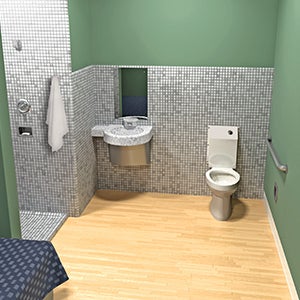
SAFE AND SOUND
The SafeCare Ligature- Resistant Series is designed to enhance patients’ feelings of a familiar, safe, home-like environment. Bradley Corp.
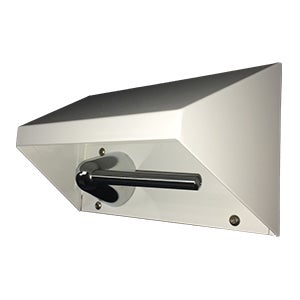
SLIGHT MODIFICATION
The C-400 Safety Toilet Paper Holder looks and functions like a standard toilet paper holder, but sloped housing and dropping spindle eliminate ligature attachment points. Cascade Specialty Hardware Inc.
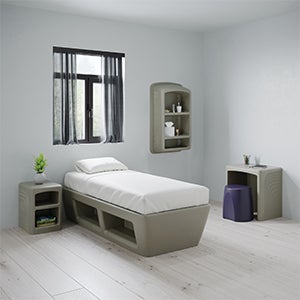
PEACEFUL ATMOSPHERE
The new Ryno bedroom range has anti-ligature features that provide extra safety and peace of mind for health care environments. Pineapple Contracts Inc.
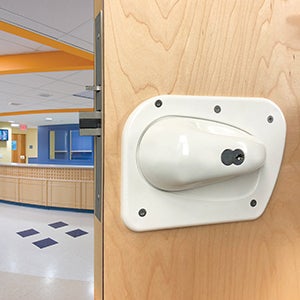
TEAM PLAYER
The Solis trim provides a durable, ergonomic design, improving patient safety while complementing the goal of creating a healing environment. Securitech Group Inc.
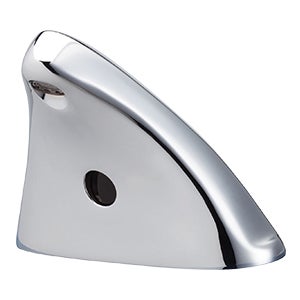
HANDS-FREE OPERATION
The ELR Series touchless faucet with built-in ligature resistance is designed for hospitals and mental health facilities. Chicago Faucets
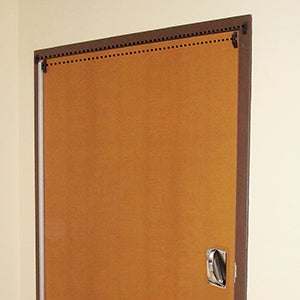
STAFF SUPPORT
The Top Door Alarm system alerts hospital staff in the event a patient uses a foreign object as a ligature point at the top of a door to commit self-harm. Door Control Services Inc.
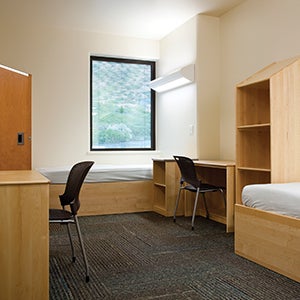
THE RIGHT SETTING
This line of behavioral health products, including casegoods, desks, beds and seating, offers a comforting, residential feel for patient, lounge and group areas. Nemschoff Inc.
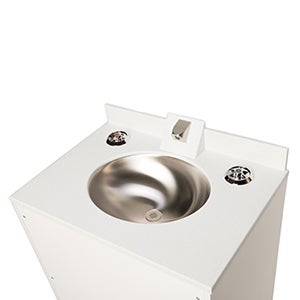
CONVENIENT CONTROL
The SP-11 Lavatory is available with knob controls so patients have control over their water flow and temperature. Odd Ball Industries
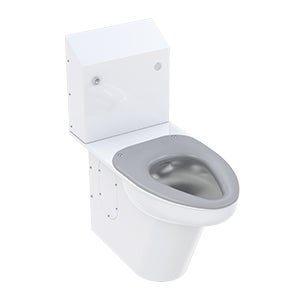
QUICK SOLUTION
The BestCare Ligature-Resistant Toilet features adjustable rough-ins for faster retrofit installation. Whitehall Manufacturing Co.
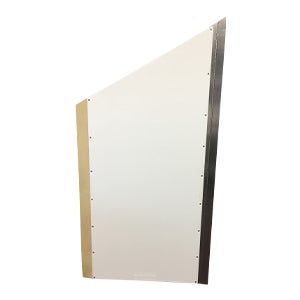
SMART DESIGN
The Sentinel Event Reduction Door is designed so it has no ligature or hanging points on any of its sides. Norva Plastics Inc.
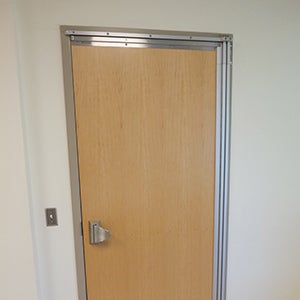
SOUND THE ALARM
A pressure-sensitive device sends an audible alarm and strobe when a ligature device is placed across the top of the door. The Door Switch
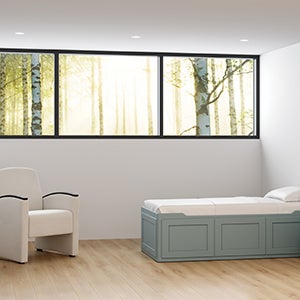
CALM AND STEADY
The Frontier Collection is constructed of impact-resistant, polyethylene material that withstands high levels of abuse. Stance Healthcare Inc.




